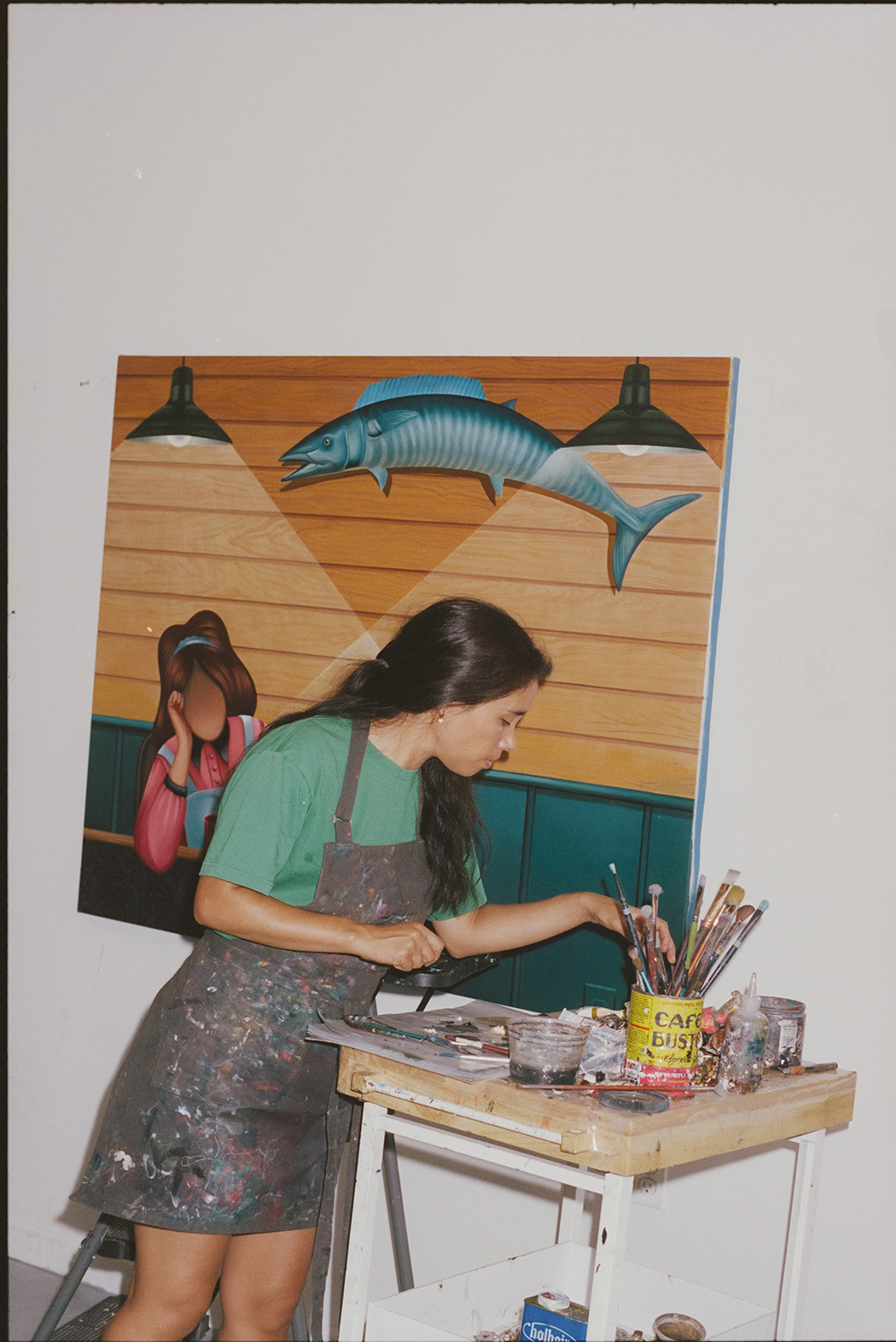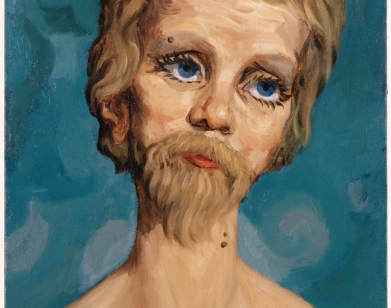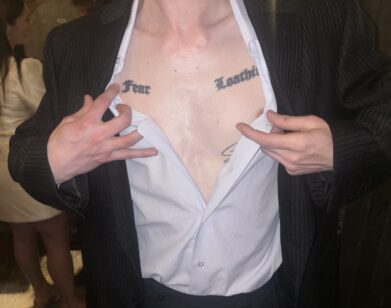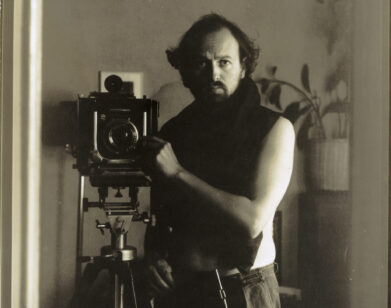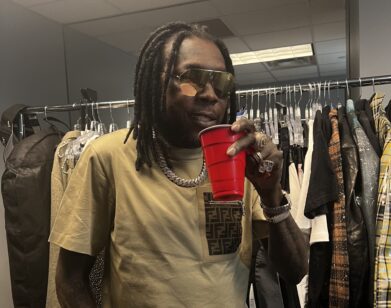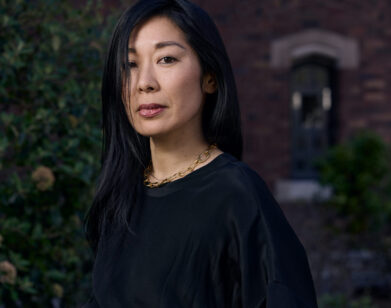STUDIO VISIT
Julie Curtiss and Anna Weyant on MorbidFascinations and Lynchian Fantasies
Among the characteristics uniting the artists Julie Curtiss and Anna Weyant, apart from their shared predilection for painting the female body in striking, bulbous, and neo-surrealist forms, is a strange and somewhat paranoid relationship with death. “When I was a teenager, I seriously thought I was going to die every night,” Curtiss told Weyant on a Zoom last week. “I was really neurotic.” Weyant, too, has macabre visions of her own demise, particularly when aboard an aircraft. “I should probably see a therapist about it,” the 30-year-old painter quipped. In her new show Suburban Lawns, currently on view at the Gagosian’s Paris outpost, Curtiss has channeled these fascinations onto the canvas, where scenes of domestic clichés—women riding a stationary bike or pushing their children in strollers—are suffused with vivid color and energy, evoking the sort of augmented realities familiar to the filmmaker David Lynch. It’s no wonder that Blue Velvet and Edward Scissorhands, as she told Weyant, were two of her reference points. Below, the painters get deep about female figuration, postpartum sensations, and getting a rise out of the Instagram censors.
———
ANNA WEYANT: Hi. How do I get you on the screen? You’re so tiny. Oh, there. Got it.
JULIE CURTISS: How’s it going?
WEYANT: Good.
CURTISS: Is that your place?
WEYANT: This is my apartment, yeah.
CURTISS: Oh my god.
WEYANT: My dog is right there. Can you see her?
CURTISS: Yeah. Do you paint in there?
WEYANT: Yeah. I can show you later if you want.
CURTISS: I love that. We’re both in New York, but it’s such a different vibe.
WEYANT: Are you back in the city?
CURTISS: Yeah, I just came back yesterday.
WEYANT: Are you exhausted?
CURTISS: Yes. I want to hang out in my sweatpants for two weeks now. That’s the plan.
WEYANT: That’s what I do.
CURTISS: I kind of want to hide. Usually when you travel for work, it always feels like work. This time it felt like vacation because I didn’t have the baby around. I was remembering to think about myself all day long. That was crazy.
WEYANT: How was the trip?
CURTISS: It was amazing. I’m from Paris, but every time I come back, especially because I come back in more fancy settings than the way I lived in Paris when I grew up, I’m like, “Wow, it’s so beautiful.” The weather was incredible. The whole thing felt like a dream, really. How was Nashville?
WEYANT: It was really fun. I went to an aquarium, so I was thinking about your show.
JULIE CURTISS Oh, here you go.
WEYANT: I love that space. Is it Castiglione?
CURTISS: Yeah, Castiglione. It’s a bit like an aquarium too.
WEYANT: And the work is aquarium-like. I love galleries where I don’t feel pressure to go inside and have to walk by security and stuff.
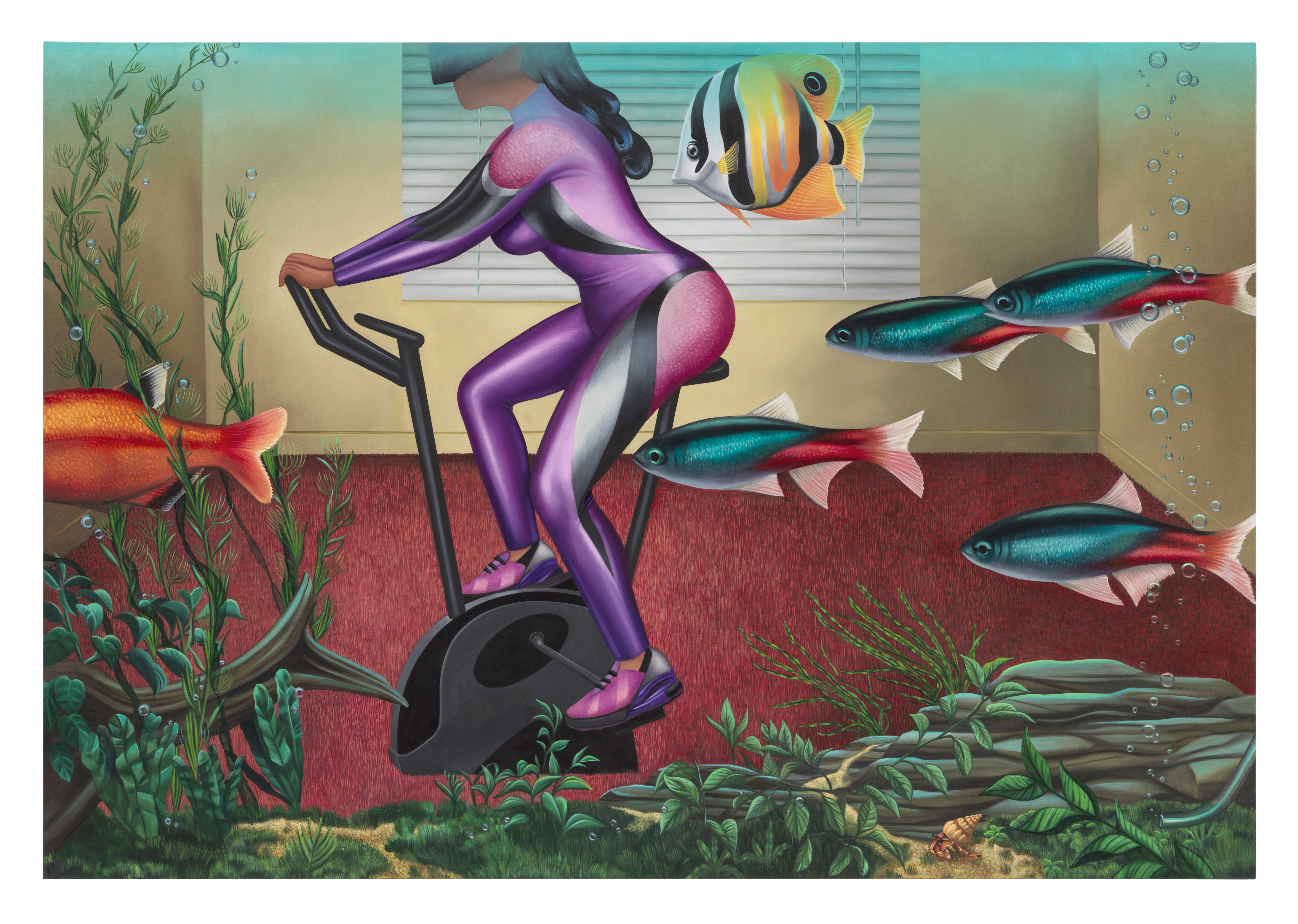
Julie Curtiss, In the Flow, 2025, Oil and acrylic on canvas, 55 x 80 inches (139.7 x 203. 2 cm), © Julie Curtiss, Photo : Maris Hutchinson, Courtesy Gagosian
CURTISS: Is that a John Currin behind you?
WEYANT: It’s my baby.
CURTISS: Wow.
WEYANT: Every morning I just sit here and have my tea and look at it. You have to come over.
CURTISS: Yeah, I want to see it.
WEYANT: Your show was just brilliant.
CURTISS: What’s your take on it? I like to hear what resonates for people because it’s often different.
WEYANT: I thought it was funny and sad and claustrophobic. I felt really lonely. There’s something so isolating about it, almost like the roof is caving in over me when I’m in that space. Not caving in, but maybe just shrinking slowly. But then it’s also so beautiful. You have these really saturated colors and big flowers, but then even the flowers are all sharp and aggressive. You know that little town in Edward Scissorhands?
CURTISS: Yeah.
WEYANT: Your show is called Suburban Lawn. Every lawn is so beautifully manicured and it’s almost like this set. It’s so green and so lush, but there’s this lifelessness to it. It’s so synthetic.
CURTISS: It’s crazy you mention that because it was part of my reference for the work. That and [David] Lynch, of course—Blue Velvet.
WEYANT: Oh, no way.
CURTISS: Yeah. I also had a talk at the University of South Florida, where I showed two slides. One of Edward Scissorhands and one of Blue Velvet. Someone raised their hand and said, “That town in Edward Scissorhands is one hour away from us.”I don’t know if they painted it just for the movie, but you can visit it. It’s like one hour from St. Petersburg, Florida, where I have a house.
WEYANT: I have to visit it. Will you FaceTime me when you’re there?
CURTISS: Yes. Isn’t it crazy it’s a real place?
WEYANT: That is so cool. So, a lot of your work seems to be about motherhood. I know you recently became a mother. Can I say your baby’s name on this call?
CURTISS: Yeah, Indigo.
WEYANT: My first question is, what’s it like to be you right now? When I see your work, it feels like I’m reading a diary that someone is keeping of their dreams, really disorienting with little pieces and scenes that are all cloudy and surreal. I want to know about your life right now.
CURTISS: The whole experience from trying to conceive, then being pregnant, to giving birth, then the baby changes month to month. When I just gave birth, it was the hardest for the first three, four months. But afterward, I was so tired that the sense of confusion, the destabilizing sensations, maybe translated on the canvases. Now I’m feeling more back to myself because the baby is changing all the time. It’s almost like you’re turning a new page every two or three months. It’s incredible. My brain is thoroughly transformed. It’s just getting more fun as the child is growing and is doing more funny, ridiculous stuff all the time. I feel like I’m already at a different place from when I started the paintings. The first thing I did after giving birth was that deep take of the mothers pushing the strollers. It still felt so alien to me to be a mother. I was more like that painting with the pregnant women and the shadow of the palm trees on the big wall of the mall. It actually was a photo of the mall I took in Florida, and that was more me. It was like, “What’s going on?” It felt like a lot of ominous shadows, lots of wind and lots of uncertainty. But things change, I guess.
WEYANT: That painting with the two mothers in the park is not a critique and it doesn’t feel malicious, which is something that I love about your work. You can make this incredible satirical work, and there’s nothing that feels mean about it. It’s just observations of these people who are maybe a little different than you; they’re these fantasies or veneers. I wonder what your relationship with those women is.
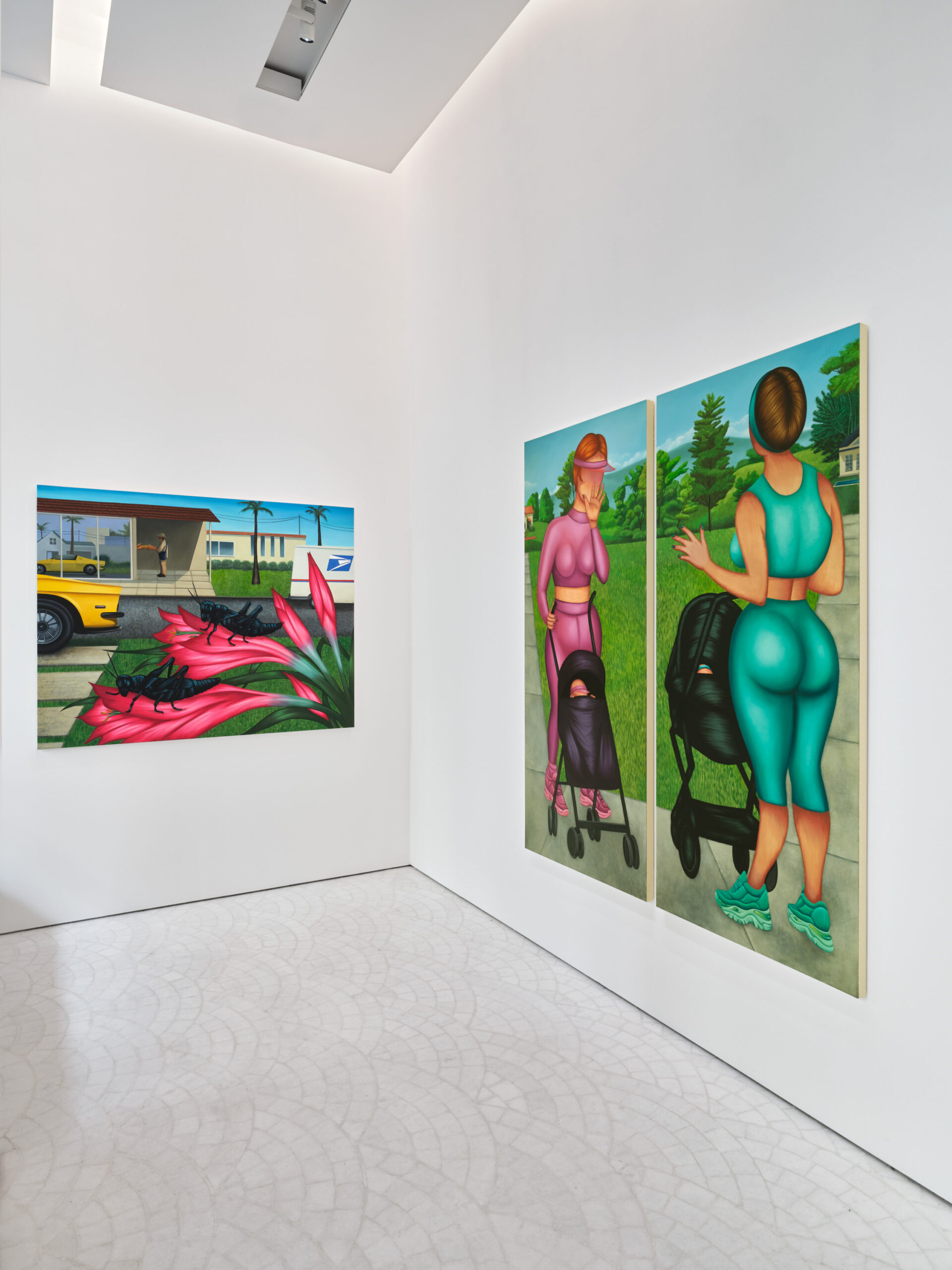
Julie Curtiss: Suburban Lawns, 2025, installation view, © Julie Curtiss, Photo : Thomas Lannes, Courtesy Gagosian
CURTISS: I don’t know if it’s satire or humor or pastiche. Every single one of my characters, or even the animals I depict, are a bit of an extension of myself. And even if they’re not, they’re still a projection, which I think you do as well with your own characters, right? How do you feel about your relationship to your characters?
WEYANT: I feel similarly. Seeing those women who bounce back and they’re spry and they have these big perky tits and tight asses. From what you’re telling me, there’s this disconnect between where they were and where you felt you were. That’s the same way I see mine—where they’re not quite me, but they’re extensions of me. Sometimes they’re extensions of my pain or my joy or my flaws. I let them exist on their own and sometimes, I exaggerate them or freeze them.
CURTISS: It’s so funny, ‘cause I never thought about the fact that they were extensions of my emotions. But now that you’re saying it, it is true. People are always like, “Why do you only paint women?” Do people ask you that as well?
WEYANT: In every interview, yes.
CURTISS: And every interview you had to be like, “Well, how do I answer that question?”
WEYANT: I know.
CURTISS: The most obnoxious question.
WEYANT: I don’t really answer it.
CURTISS: You don’t answer it?
WEYANT: Sometimes it’s a simple, “I love the female form in all its weird bulbousness.” But I don’t think that’s the true answer.
CURTISS: Have you painted dudes?
WEYANT: I’ve painted my dad twice, but I was learning how to paint. I had just moved to New York and that was more just a practice in light and shadow. I haven’t painted him recently.
CURTISS: So your dad was just your guinea pig more than any important contribution to your body of work.
WEYANT: Exactly. I just needed someone who would sit still and fall asleep for a while so I could paint them. What about you? I can think of a couple men in your paintings…
CURTISS: I paint majority women, so people don’t really pick up on the presence of men. I wonder if you’re going to start to paint more men as you’re going to get bored with the female figure eventually.
WEYANT: I think I’m already bored with it. They’re turning into these sculptures or weird abstract doll figures.
CURTISS: Yeah, they’re like cartoons now.
WEYANT: I don’t think I’m bored with the female figure. I want to expand the female figure that I paint. I am getting bored with painting myself, but then I’m also painting in these uncomfortable, unpleasant, scarce worlds, and I feel weird putting anyone else in them.
CURTISS: Actually, they seem almost like they’re from a neoclassical painting. I was wondering, how did you come to this aesthetic? In a way, it’s very European, like this language of the past. I was thinking, “It’s funny, because Anna’s world is as if it was from the past with glimpses of the present.”
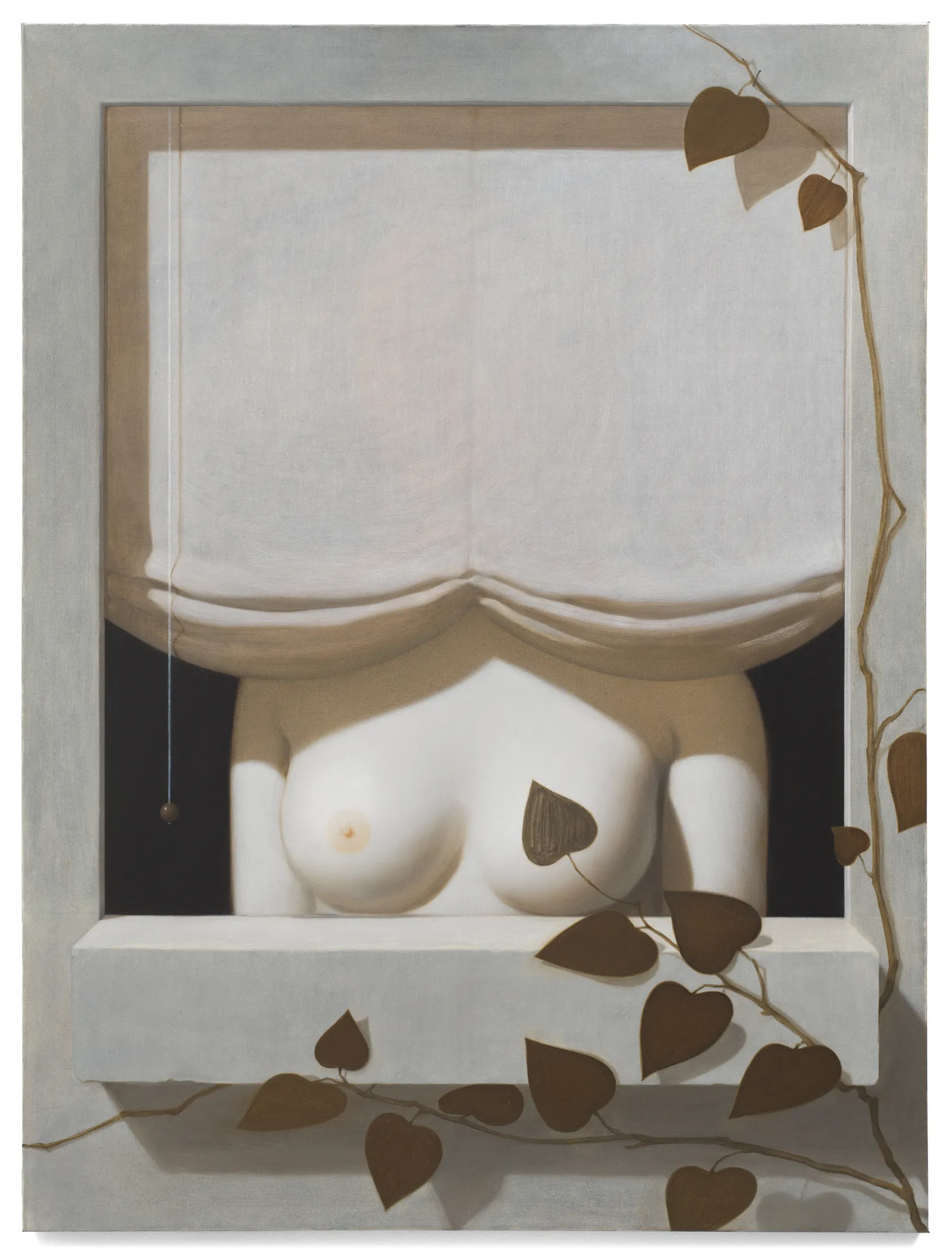
Anna Weyant, Girl in Window, 2024, oil on canvas, 48 × 36 inches (121.9 × 91.4 cm) © Anna Weyant. Photo: Maris Hutchinson.
WEYANT: I really started painting because I fell in love with John Currin’s paintings when I was in college. I saw a show and I thought it was brilliant and I wanted so badly to make John Currin paintings. I tried, and they just looked like these shitty John Currin paintings. Eventually, I was able to crawl out of this massive shadow that he created, because he’s so monumental and genius, and find a little niche where I could exist and paint.
CURTISS: I was looking at your early paintings and it’s almost like your palette reduced more as you worked. The colors became more contrasted and more desaturated. It was interesting to go back to the first ones as well. I was wondering why there’s a lot of memento mori in your work. Maybe it’s also in mine, but it’s not as obvious. I’m sure these are conscious marks you’re making, right?
WEYANT: They are and they aren’t. I don’t know if pessimist is the right word, because I think I’m actually positive and joyful while feeling like the world is about to end every night, but I go to bed every night thinking, “This will be the night I get murdered.” I should probably see a therapist about it.
CURTISS: Really? Still now?
WEYANT: Still now.
CURTISS: When I was a teenager, I seriously thought I was going to die every night. I was really neurotic. I think it’s because I just couldn’t project myself into the future. I couldn’t imagine myself becoming an adult. And eventually, I became an adult.
WEYANT: It just kind of happens.
CURTISS: It just happens. But I had this whole phase where, for some reason, I thought I was going to die before I was 18. But like you say, I’m usually positive except for those really dark episodes.
WEYANT: Yeah. Every plane I get on I’m like, “I’m going to die and my skin’s going to get ripped off as I fly through the air to the ground.”
CURTISS: Maybe that’s where the humor comes from? We share quite a few things in our themes and interests, probably because of our morbid tendencies.
WEYANT: Maybe it’s a laugh or die situation. You kind of have to keep going, even if you think you’re going to get murdered.

Julie Curtiss, Téléphone Rose, 2025, Oil and acrylic on canvas, 40 x 34 inches (101.6 x 86.4 cm), © Julie Curtiss, Photo : Maris Hutchinson, Courtesy Gagosian
CURTISS: We grew up in a well-fed and pretty comfortable environment. Why are we talking about life and death?
WEYANT: I have no idea. I have an alarm system in my apartment. I’m in a doorman building. I lock all the doors. Every night, I unplug the lights so they don’t catch on fire. I still get into bed and picture somebody from Mission Impossible scaling the building and coming in. And it’s completely irrational.
CURTISS: You got the wrong dog then.
WEYANT: I’ll be awake at night thinking about ghosts and she’ll just start barking at a doorway. She does not help my anxiety at all. But I don’t know where the fear comes from and I don’t know where the humor comes from.
CURTISS: I’d say the humor is probably a coping mechanism, or a balance for the fear. But I don’t sense any fear in your work. What I sense in your work is the little twisted element, or the passive-aggression or the subversion.
WEYANT: Mm-hmm.
CURTISS: But I don’t know if I have a theory about where mine comes from. It’s probably from growing up as a little girl wanting to always meet people’s expectations, being more or less a people-pleaser.
WEYANT: That makes more sense to me than every jumbled up thought in my brain that I was just trying to organize.
CURTISS: [In your work], I wonder where all these little twisted things, like the hole in the pantyhose or the bandage on the hand, come from. Your characters have all these polished external facades, but then there’s always a little scratch in the varnish.
WEYANT: Sometimes there’s this childish desire in me that’s like, “I want to see what I can get away with.” Recently, I made this painting of a vagina that was falling from the sky. It was the bottom half of a woman, and the skirt was being blown up.

Anna Weyant, That’s All Folks, 2024. Oil on canvas, 48 x 36 inches. © Anna Weyant. Photo: Owen Conway.
CURTISS: You’re talking about the one in London, right?
WEYANT: In London. We were working on these advertisements for the show that would go in the Tube. But they didn’t want an image I had of this woman’s nipple because it was a public space. And it’s so fucking egregious to show a woman’s nipple. It’s shocking.
CURTISS: You don’t want nipples and vaginas in the subway?
WEYANT: Instagram shadow-banned me over it because I posted the painting. So I have this rebellion against it. It’s like, “No, fuck you. I’m going to paint this vagina and I’m going to put it in a private space in London. And when you walk by with your kids, you’re going to have to look at it because I’m a woman and I’m here in this gallery.” But for the Tube, the City of London wouldn’t let us use the image. But then for the gallery, we could show whatever we wanted. You could see it from the street.
CURTISS: Were some people shocked or outraged, or nothing?
WEYANT: Instagram was, but not people. But maybe institutionally, there were these larger social pushbacks. It wasn’t a culture shifting painting or anything. It was really small. I don’t think I was going for shock value or anything as much as just this quiet, personal pushback. When Larry [Gagosian] saw the painting, he was like, “Don’t paint any more vaginas because they don’t sell well.” I was like, “I’ve got a bloody vagina.”
CURTISS: That’s the number one I would’ve bought.
WEYANT: It was my favorite.
CURTISS: One of my favorite paintings is The Origin of the World at the D’Orsay Museum.
WEYANT: Oh, I love that painting. It’s interesting what is censored and what isn’t. That’s something I’m thinking about when I’m making work, because I can’t post a topless photo. Not that I’m dying to do that, but my male counterparts can. It’s a man’s nipple versus a woman’s nipple. They’re treated differently.
CURTISS: Well, I don’t think there’s a lot of women getting off on men’s nipples to be honest.
WEYANT: Why is that relevant?
CURTISS: Because they’re not charged. They don’t have the same erotic charge. In a way, I find that flattering to women. Not that I think things should be more censored than others, but I can rationalize it. David’s penis, the sculpture, is so much smaller in proportion to even his figure that it’s really not that arousing. One is censored and the other is not because of its obvious erotic charge. But I did see an erect penis in a photograph that someone managed to post on Instagram the other day and I was surprised that Instagram didn’t catch it. But it’s kind of cool to be censored. It has a big whiff of scandal, which is kind of nice.
WEYANT: Maybe. It’s almost like the thrill of a speakeasy bar where you’re doing something you’re not really supposed to be doing.
CURTISS: If there weren’t any taboos or restrictions, it wouldn’t be as naughty.
WEYANT: Yeah, what would we push against? I wish there were fewer things to push against right now.


